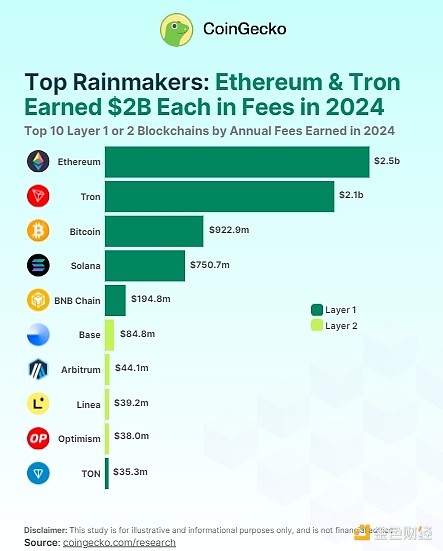
Author: Lim Yu Qian, CoinGecko; Compiled by: Deng Tong, Golden Finance
Which blockchains earn the most fees?In 2024, Ethereum has the highest fees of any blockchain, with total annual fees from gas fees of $2.48 billion. Tron became the second highest-grossing blockchain, with annual fees totaling $2.15 billion last year. This means that on a daily average basis, Ethereum generated $6.79 million in daily fee revenue last year, while Tron generated $5.89 million in daily fee revenue.
Bitcoin and Solana follow, with annual fees of $922.89 million and $750.65 million respectively.
Overall, Layer 1 (L1) and Layer 2 (L2) blockchains earned more than $6.89 billion from transaction fees in 2024. Specifically, L1 recorded $6.6 billion in fees across 21 blockchains, while L2 recorded $294.92 million across 12 blockchains.
The top 10 highest-grossing blockchains alone recorded $6.74 billion in combined fee revenue. Notably, 4 of the 10 highest-grossing blockchains are Layer 2 — namely Base, Arbitrum, Linea, and Optimism — which surpassed other Tier 2 blockchains, including TON, in terms of annual fee revenue last year. 1 level.
Ethereum fee revenue over timeEthereum’s fee revenue of $2.48 billion in 2024 increased 3.0% from $2.41 billion in 2023. This shows that despite the March 2024 Dencun upgrade reducing L2 transaction costs and users migrating from L1 chains to its L2 scaling solutions, Ethereum is still maintaining its lead in fee revenue. Ethereum’s elastic fee revenue also stands in stark contrast to ETH’s price performance, which last year was below expectations.
The amount of fees earned on Ethereum fluctuates every month. In 2023, Ethereum will generate monthly revenue between $91.22 million and $448.7 million, recording higher fee revenue during the meme mania in May and the market rebound at the end of the year. The range widens in 2024, with Ethereum’s monthly revenue ranging from $62.82 million to $606.77 million.
It is worth noting that in the first quarter of 2024 alone, Ethereum made $1.17 billion, accounting for almost half of its total fee revenue for the year. It was also Ethereum’s highest revenue quarter in the past two years, driven by increased on-chain activity thanks to the widespread implementation of the airdrop program.
Tron, Solana fee incomeStrong GrowthTron’s fee income increased significantly by 116.7% last year, from $922.08 million in 2023 to $2.15 billion in 2024. As one of the largest blockchains with stablecoins, the acceleration of stablecoin usage has driven the steady growth of Tron’s monthly fee revenue, from $38.36 million in January 2023 to $342.54 million in December 2024.
Tron has surpassed Ethereum in fee revenue for the past six consecutive months, but it remains to be seen whether Tron can surpass Ethereum this year to become the blockchain with the highest fee revenue.
Solana's annual fee revenue will increase even more, from $25.55 million in 2023 to $750.65 million in 2024, an increase of 2,838.0%. Solana was the most popular blockchain ecosystem last year, with transaction volume soaring to the point of network congestion in April 2024. Unlike Tron, Solana's monthly fee revenue remained flat throughout 2023 and experienced more erratic growth in 2024, rising from $15.54 million in January to $197.5 million in November and then to $197.5 million in December. slowed to $120.95 million.
In comparison, Bitcoin’s annual fee revenue grew by 15.9% and BNB Chain’s 8.7%, a much more modest increase but still more than Ethereum’s 3.0%. Bitcoin’s chargeability has grown in recent years, driven by increased activity in Ordinal NFTs, BRC-20 and Rune tokens, as well as rapidly growing interest in building on top of Bitcoin.
At the same time, TON ranks tenth and the blockchain with the highest fees, with annual fee revenue of US$35.28 million last year. Previously, popular messaging app Telegram officially integrated TON, enabling more accessible on-chain interactions such as click-to-earn blockchain games.
Which Tier 2 earn the most fees?Base earns the most gas fees among L2, generating US$84.78 million in 2024. This is a 548.2% increase from the $13.08 million in annual fees earned in 2023, although it’s worth noting that Base only launched its mainnet in August 2023.
Even accounting for the mainnet launch, Base's fee revenue tripled from a quarterly average of $6.38 million in the second half of 2023 to $21.2 million in 2024. Like Solana, Base has seen widespread adoption due to its retail friendliness, which is further amplified by its integration with CoinbaseSuch friendliness.
Similarly, Linea’s mainnet launches in August 2023, which partly explains the increase in annual fee revenue from $24.2 million in 2023 to $39.2 million last year US dollars, an increase of 62.0%. Linea received most of its 2024 annual fees in the first quarter, when it hit a quarterly high of $31.4 million during the Linea Park airdrop event.
Meanwhile, Optimism's annual fee revenue edged up 1.9%, from $37.26 million in 2023 to $37.97 million in 2024.
Arbitrum, zkSync fee revenue shrinksArbitrum is the second-largest L2 with the highest fee revenue, at $44.1 million in 2024. However, that's down 30.1% from the $63.12 million Arbitrum earned in 2023. Despite being established players, both Arbitrum and Optimism face serious challenges in the increasingly competitive L2 space.
zkSync will see an even steeper drop, from $60.04 million in annual fees in 2023 to $24.27 million in 2024, a drop of 59.6%. Specifically, during the L2 airdrop point program, zkSync's quarterly fee revenue averaged $20.04 million from the second quarter of 2023 to the first quarter of 2024, but then from the second quarter to the fourth quarter of 2024, the average quarterly revenue plunged to $990,000.
Overall, the current fluctuations in L2 fee revenue appear to primarily reflect on-chain activity driven by token airdrops and incentive marketing programs. Therefore, it remains to be seen how much fees the L2 chain can earn in the long term.
Blockchains ranked by fee incomeThe total annual fees earned by blockchains in 2024 are as follows:










